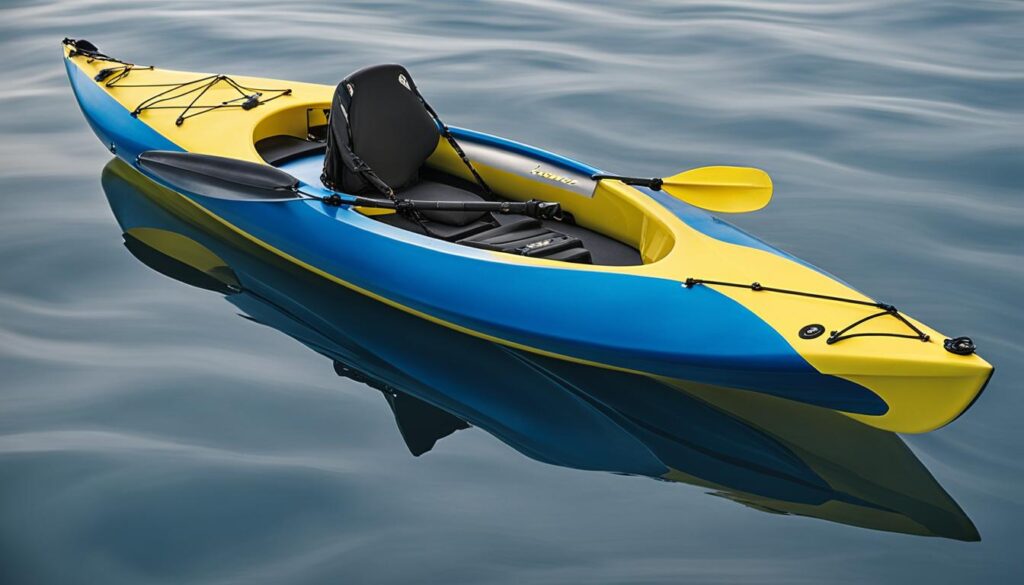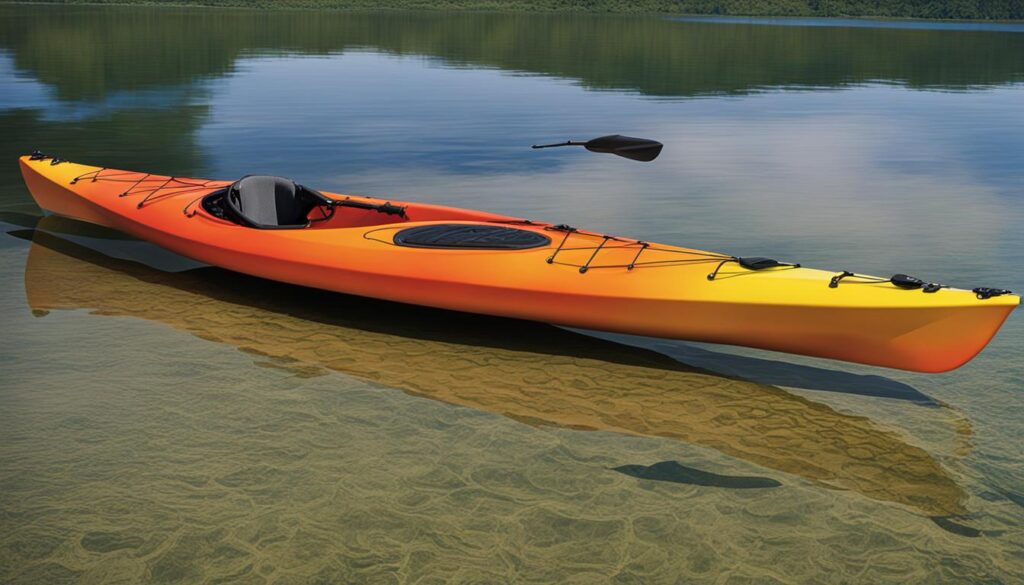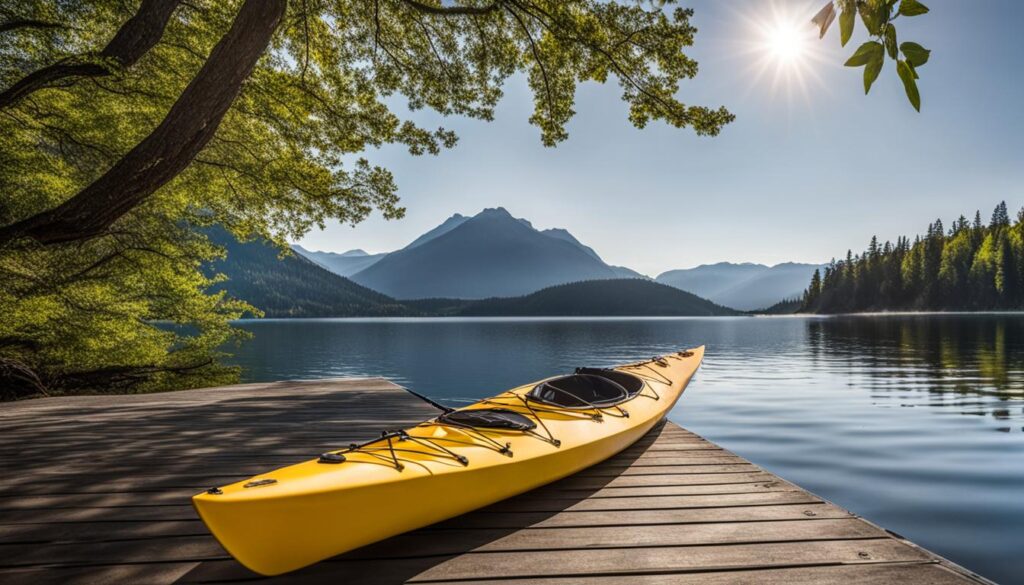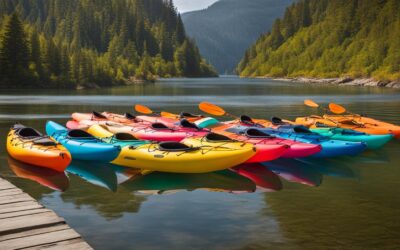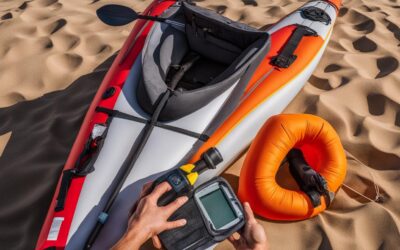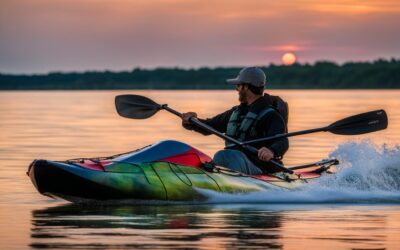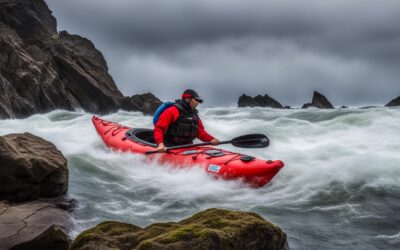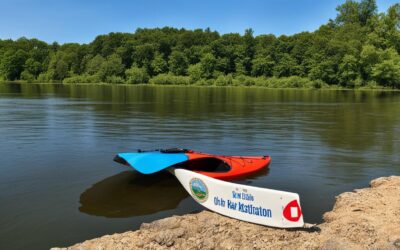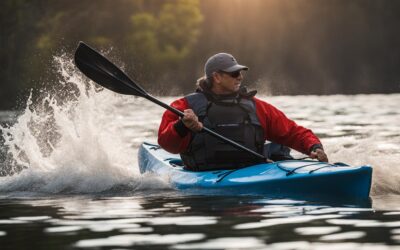The material a kayak is made of can greatly impact its performance, durability, weight, and overall aesthetic appeal. If you’re in the market for a new kayak, it’s important to understand the different materials used in their construction. By knowing the pros and cons of each material, you’ll be able to choose the kayak that best suits your needs and preferences.
Key Takeaways:
- There are various materials used to construct kayaks, including polyethene, fibreglass, aramid (Kevlar), graphite, thermoformed ABS-acrylic, rotomolded polyethene, inflatable PVC, and folding kayaks made from polyurethane, nylon, or fabric skins.
- Polyethylene kayaks are widely used and inexpensive but tend to be heavier than other options.
- Thermoform kayaks offer a mid-range compromise between plastic and composite kayaks, balancing affordability, durability, and aesthetics.
- Composite kayaks, made from fibreglass, aramid, and carbon fibre, offer superior strength-to-weight ratio and performance.
- Wooden kayaks have a unique aesthetic appeal and can be as durable as composite kayaks when properly finished, but they require woodworking skills or professional construction.
- Folding and inflatable kayaks provide options for those with limited storage space or need for portability but may not offer the same performance or durability as hard-shell kayaks.
- Choosing the best kayak material depends on intended use, storage space, transportation, and desired performance.
Hard-shell Kayak Materials
There are various materials to choose from when it comes to hard-shell kayaks. Each material has unique characteristics affecting weight, durability, performance, and cost. Understanding the different types of kayak materials will help you decide when selecting the right kayak for your needs.
Some of the most common hard-shell kayak materials include:
- Rotomolded polyethylene
- Thermoformed ABS-acrylic
- Composite materials (such as fibreglass, aramid, or graphite)
- Wood
- Polycarbonate
Let’s look at each material and understand their advantages and disadvantages.
| Material | Advantages | Disadvantages |
|---|---|---|
| Rotomolded Polyethylene | Durable, versatile, impact-resistant | Heavier, susceptible to UV damage |
| Thermoformed ABS-Acrylic | Attractive finish, scratch-resistant, good performance | Not as durable as composite materials |
| Composite Materials | Superior strength-to-weight ratio, excellent performance | More expensive, may require professional repairs |
| Wood | Unique aesthetic appeal, durability | Requires woodworking skills or professional construction |
| Polycarbonate | Exceptional impact resistance, durability | Not as widely available |
Rotomolded Polyethylene Kayaks
Rotomolded polyethene is a favoured kayak material due to its cost-effectiveness and durability. The manufacturing process involves melting and evenly distributing polyethene powder in a mould, resulting in an impact-resistant kayak well-suited for rough use.
These kayaks are versatile and ideal for various kayaking activities such as whitewater, fishing, recreational, and entry-level touring. Their sturdiness is particularly beneficial for beginners or kayaking in rocky areas.
However, they are heavier than kayaks made from other materials, posing transport and handling challenges, particularly for one person. Also, prolonged exposure to UV rays can fade their colour and weaken the material.
Advantages and Disadvantages of Rotomolded Polyethylene Kayaks
| Advantages | Disadvantages |
|---|---|
| – Affordable | – Heavier than other materials |
| – Durable and impact-resistant | – Susceptible to UV damage |
| – Versatile for various types of kayaking |
Despite the disadvantages, rotomolded polyethene kayaks are popular for their durability and affordability. If you’re a beginner or planning to kayak in demanding environments, a rotomolded polyethene kayak might be the ideal option.
Thermoform Kayaks: Lightweight, Durable, and Affordable
Thermoform kayaks are a popular choice for paddlers seeking a mix of affordability, performance, and aesthetics. They blend the durability and cost-effectiveness of plastic with the lightweight, sleek design of composite kayaks. Their construction uses a plastic laminate method, involving ABS plastic sheets layered over a mould and shaped through heat and vacuum.
These kayaks are notably lighter than polyethene models, making them easier to transport and manoeuvre. Their lightweight enhances on-water performance, providing agility and responsiveness. They also offer superior resistance to impacts, abrasions, and UV damage and are easier to repair than polyethene kayaks, making them a practical choice for regular use.
Thermoform kayaks feature a polished, scratch-resistant finish, similar in appearance to composite kayaks. This aesthetic appeal, durability and performance make them suitable for various activities, including recreational paddling, touring, and moderate whitewater adventures. They offer a balanced solution for paddlers looking for a lightweight, durable, and visually appealing kayak.
| Benefits of Thermoform Kayaks |
|---|
| – Lightweight design |
| – Durable construction |
| – Attractive finish |
| – Scratch resistance |
| – Improved performance |
| – Easier to repair than polyethene kayaks |
Composite Kayaks
Composite kayaks are highly sought after by paddlers who prioritize performance, responsiveness, and a lightweight design. These kayaks are constructed using resin-impregnated laminates of fibreglass, aramid (Kevlar), carbon fibre, or a combination of these materials. Each material offers its unique benefits and considerations.
Fiberglass Kayaks
Fiberglass is the most commonly used composite material in kayak construction. It strikes a balance between cost, durability, and weight. Fibreglass kayaks are known for their strength and resilience, making them suitable for various paddling activities. They offer good performance and responsiveness on the water, making them popular for recreational and touring purposes.
Aramid Kayak Construction
Aramid, commonly known as Kevlar, is another material used in composite kayak construction. Aramid kayaks are lightweight and possess exceptional strength, making them ideal for paddlers who prioritize speed and efficiency. While aramid kayaks are more expensive than their fibreglass counterparts, they are highly durable and perform excellently in challenging conditions.
Carbon Fiber Kayaks
Carbon fibre kayaks represent the pinnacle of composite kayak technology. These incredibly lightweight kayaks have impressive stiffness, resulting in unparalleled performance. Carbon fibre kayaks excel in speed, manoeuvrability, and responsiveness. However, they have a higher price tag than fibreglass and aramid kayaks.
| Material | Benefits | Considerations |
|---|---|---|
| Fiberglass | – Cost-effective option – Good durability – Versatile performance |
– Slightly heavier than aramid and carbon fiber |
| Aramid (Kevlar) | – Lightweight – Exceptional strength – Excellent performance |
– Higher price point |
| Carbon Fiber | – Extremely lightweight – Superior stiffness – Unparalleled performance |
– Higher cost |
When considering a composite kayak, assessing your paddling needs and budget is important to choosing the right material. Fiberglass kayaks offer a balanced combination of cost, durability, and performance. Aramid kayaks provide increased strength and lighter weight at a higher price point. Carbon fibre kayaks deliver top-tier performance but come with a premium price tag. Whatever material you choose, a composite kayak will provide you with a high-performance vessel for your paddling adventures.
Wooden Kayaks
Wooden kayaks offer a unique and aesthetically pleasing option for paddlers looking for a more traditional approach to kayak construction. There are two main methods of building wooden kayaks: stitch-and-glue construction and strip-built construction.
Stitch-and-Glue Construction
Stitch-and-glue construction is a popular method for DIY enthusiasts and those with limited woodworking experience. It involves cutting out plywood pieces, stitching them together with wire or zip ties, and then glueing the seams with epoxy resin. This construction method allows for easy assembly without the need for complicated woodworking techniques.
Strip-Built Kayaks
Strip-built kayaks, also known as cedar strip kayaks, are constructed by gluing together thin strips of wood, usually cedar, over a form or mold. This method allows for endless design possibilities, as the strips can be arranged in various patterns to create unique and visually striking kayaks. Strip-built kayaks are known for their strength, durability, and lightweight nature.
Pros and Cons of Wooden Kayaks
Wooden kayaks have several advantages and considerations to keep in mind:
- Pros: Wooden kayaks offer a beautiful and classic look, with the wood’s natural grain adding to their appeal. They can be as durable as composite kayaks when properly finished with fibreglass, resin, and varnish. DIY enthusiasts have the satisfaction of building their own kayak. Wooden kayaks are also repairable, allowing for easy fixes if any damage occurs.
- Cons: Wooden kayaks require woodworking skills or hiring a professional for construction. They can be more time-consuming and labour-intensive to build than other kayak materials. Additionally, they require regular maintenance, including refinishing and varnishing, to protect the wood from water damage and UV exposure.
In summary, wooden kayaks offer a unique and visually appealing option for paddlers who appreciate the craftsmanship and beauty of wood. By choosing the right construction method and carefully maintaining the kayak, wooden kayaks can provide an enjoyable and durable paddling experience.
Folding and Inflatable Kayaks
When choosing a kayak, various options are available, including folding and inflatable kayaks. These types of kayaks offer unique advantages that may appeal to certain paddlers. Let’s look closer at folding and inflatable kayaks, including their materials and construction.
Folding Kayaks
Folding kayaks are designed to be portable and easily stored. They are constructed using polyurethane, nylon, or fabric skins stretched over a wood or aluminium frame. This combination of materials allows for flexibility and manoeuvrability while maintaining durability.
One of the key benefits of folding kayaks is their compact size and lightweight nature. They can be easily folded and transported in a backpack or storage bag, making them ideal for individuals with limited storage space or those who enjoy travelling to different paddling locations.
While folding kayaks offer convenience and portability, it’s important to note that they may not provide the same performance or durability as hard-shell kayaks. The folding frame design can result in slightly reduced stability and responsiveness compared to their rigid counterparts. However, advancements in design and materials have improved the overall performance of folding kayaks in recent years.
Inflatable Kayaks
Inflatable kayaks, as the name suggests, are constructed using PVC material that can be easily inflated and deflated. They offer the advantages of compact storage and convenient transportation. Inflatable kayaks are often lightweight and can be carried in a backpack or stored in a small space when not in use.
One of the main benefits of inflatable kayaks is their versatility. They can be used for a variety of activities, including recreational paddling, fishing, and even whitewater kayaking. In addition, inflatable kayaks are often more affordable compared to hard-shell kayaks, making them a popular choice for beginners or occasional paddlers.
While inflatable kayaks are convenient and budget-friendly, they may not provide the same level of speed and agility as hard-shell kayaks. The flexibility of the material can result in slightly reduced performance, especially when navigating rough waters or strong currents. However, advancements in inflatable kayak construction have led to improved durability and stability.
Choosing the Best Kayak Material
When selecting the best kayak material, you have several options to consider. Each material offers its own unique benefits and drawbacks, so it’s important to understand the key factors before making your decision.
Polyethylene: Durability and Affordability
Polyethylene is a popular choice for kayakers looking for durability and cost-effectiveness. This plastic material is known for its impact resistance, making it ideal for activities like whitewater kayaking and fishing. However, keep in mind that polyethylene kayaks tend to be heavier than other materials and may be susceptible to UV damage over time.
Composite: Lightweight and High Performance
If lightweight and high performance are your priorities, consider a composite kayak. These kayaks are typically made from materials like fiberglass, aramid (Kevlar), or carbon fiber. Composite kayaks offer superior strength-to-weight ratios, durability, and a sleek design. However, they do come with a higher price tag compared to other options.
Thermoform and Wood: A Balance of Cost and Performance
For those seeking a balance between cost and performance, thermoform and wooden kayaks are worth exploring. Thermoform kayaks combine the durability and affordability of plastic with the lighter weight and attractive finish of composites. Wooden kayaks, on the other hand, offer a unique aesthetic appeal and can be as durable as composite boats when properly finished. However, building or purchasing a wooden kayak may require woodworking skills or professional assistance.
Ultimately, the best kayak material for you depends on your specific needs, preferences, and budget. Consider factors such as intended use, storage space, transportation, and desired performance. Take your time to assess and compare the different materials before making an informed decision. By doing so, you’ll be well-equipped to choose a kayak that will provide you with enjoyable and rewarding paddling experiences.

